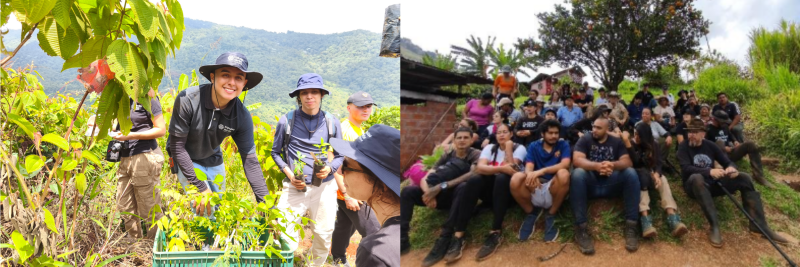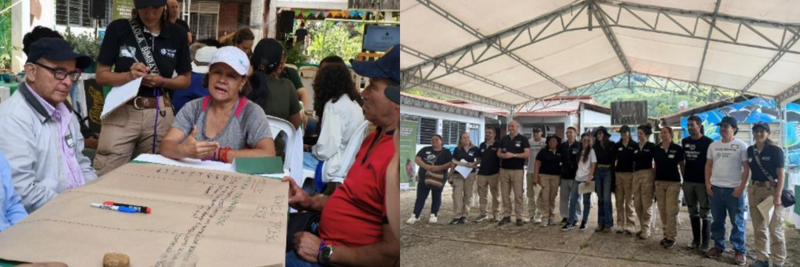
Community forest restoration to conserve the Golden Mountain Eagle in the Farallones de Cali

©Sighting of juvenile Spizaetus isidori in Farallones de Cali. Bertulfo Bermúdez, 2025
October 30, 2025
In the rugged landscapes of the Farallones de Cali National Natural Park, in the heart of the Andean biogeographic corridor, Impulso Verde Kuaspue Foundation and the Critical Ecosystems Partnership Fund (CEPF) are leading a community ecological restoration process aimed at conserving the habitat of the mountain golden eagle (Spizaetus isidori), an IUCN Endangered species.
The project is being developed in the villages of Pueblo Nuevo, Peñas Blancas and Quebrada Honda, where rural communities have assumed a leading role in the recovery of the forest, facing threats such as deforestation, soil degradation and loss of ecological connectivity.
Since 2023, more than 3,600 native trees have been planted thanks to a strategy that combines technical support, practical training, and family participation. The follow-up carried out in 2025 confirmed a survival rate of 92%, a result higher than the regional average that shows the success of the community restoration model promoted by Impulso Verde. This year, 850 additional trees were planted and 25 hectares of forest have been preserved, strengthening the resilience of the territory in the face of climate change and generating conditions conducive to biodiversity.
“Taking care of the habitat of the golden mountain eagle is taking care of my farm,” says Jeimy Caicedo, a local leader of the village of Pueblo Nuevo in the village of Los Andes. “And when each farm takes care of its forest, the whole mountain breathes.”

©Planting of 300 native trees in Pueblo Nuevo on Jeimy Caicedo’s agroecological farm – Fundación Impulso Verde, 2025
In addition, a pilot project was implemented for the control of the pig fern (Pteridium aquilinum), an invasive species that limits natural regeneration. The results showed that the combination of periodic cuts and lime application significantly reduces its coverage, offering a technical tool that can be replicated in other Andean restoration processes.
In parallel, a monitoring plan for the golden mountain eagle was developed with 15 days of observation in the townships of Los Andes, at altitudes between 900 and 2,000 meters. This activity achieved a great result: the confirmed observation of 4 individuals in different stages of growth! In addition to the identification of nesting areas, flight paths and habitat conditions, key information for the long-term monitoring of the species in the Tropical Andes Hotspot.
Women, agroecology and flourishing knowledge
The restoration of the ecosystem is also promoted through the transformation of production systems towards sustainable models. In this regard, the project strengthened the local capacities of 43 people, mostly women, with workshops on ecological restoration, agroecology and meliponiculture.
Under the “learning by doing” methodology, the adoption of agroecological practices in 18 coffee, vegetable and fruit production units was supported, promoting the protection of pollinators, especially native stingless bees, essential allies for production and biodiversity.

© Sample of products from agroecological farms at the experience exchange event – Fundación Impulso Verde, 2025
At the institutional level, Impulso Verde has made progress in formulating its gender equality policy, built through a participatory process with a transgenerational and multicultural approach. The plan included six theoretical-practical workshops that integrated the principles of equity and respect for diversity in the organizational culture, strengthening female leadership in conservation processes.
The leaders of Impulso Verde also participated in advocacy and learning spaces, such as the World Summit of Women Biodiversity Caregivers at the Biodiversity Week held in Cali and the exchange tour in the Ñambí River Reserve, in the department of Nariño, in partnership with the Tropico Foundation.
Guardians of the Eagle, Guardians of the Territory
One of the most significant milestones was the closing community meeting held in Peñas Blancas, where more than 80 people, including environmental authorities, producers and young people from the townships of Los Andes and Pichindé, shared progress, challenges and joint projections.
From this space arose the proposal to hold an Eagle Festival, promoted by the community of Pueblo Nuevo, as an opportunity to celebrate biodiversity, strengthen territorial identity and promote nature tourism.
This process has had tangible repercussions and has led to the acquisition of in-depth knowledge. Communities have shown increased interest in agroecological practices and ecosystem restoration, recognizing that eagle conservation requires community governance and local sustainability. The need to maintain permanent dialogue between communities and environmental authorities was emphasized, as was the strengthening of local solidarity-based marketing networks.

©Community dialogue at the experience exchange event – Fundación Impulso Verde, 2025
Inter-institutional work, practical learning, and continuous support proved to be keys of success, while environmental awareness consolidated social co-responsibility and the role of communities as guardians of the ecosystem.
Several participants expressed their willingness to continue monitoring the golden eagle autonomously, by setting up observation points and strengthening nature tourism initiatives, in order to ensure long-term sustainability.
Projection 2026
Based on the results and learnings obtained, the Impulso Verde is planning a new phase for 2026 under the name “Guardians of the Eagle”, which aims at consolidating the model of community restoration and territorial sustainability.
The strategic lines must include strategies where conservation and rural livelihoods are interdependent that allow ecological restoration linked to food security and sustainable income, support for the Restoration Plan of the Farallones de Cali, the articulation of an Andean network for monitoring the species and the promotion of sustainable production models. such as regenerative livestock farming.
This projection seeks to consolidate a comprehensive model of conservation, restoration and sustainable production, where community co-responsibility and institutional articulation are the pillars of the future of the Andean forest and the golden mountain eagle in the Farallones de Cali.
The phase implemented in 2025 was supported by CEPF and is a joint initiative of the French Development Agency, Conservation International, the European Union, the Hans Wilsdorf Foundation, the Global Environment Facility, the Governments of Canada and Japan, and the World Bank. In the Tropical Andes, the program is funded by the Government of Canada through Global Affairs Canada, with the purpose of strengthening civil society in biodiversity conservation.
Comunicaciones Fundación Impulso Verde
Fundación Impulso Verde Kuaspue
contacto@impulsoverde.org






